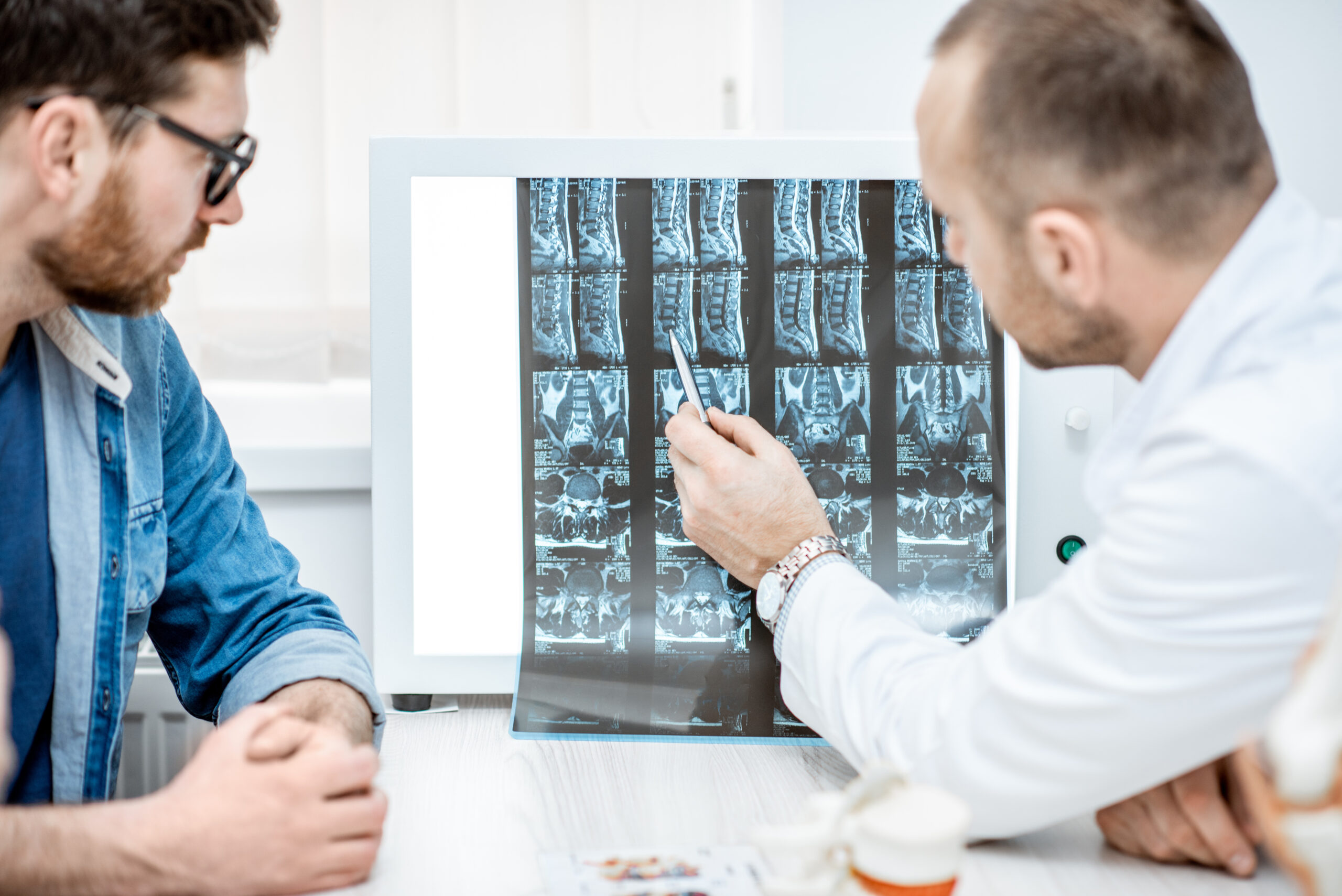
Is a Bulging Disc the Same as a Herniated Disc?
No, a bulging disc and a herniated disc are two different things. The main difference is whether the inner portion of the spinal disc (nucleus pulposus) is protruding through the annulus of the disc. The symptoms of bulging and herniated discs can be similar, but herniated discs are usually more serious.
Differences Between Bulging and Herniated Discs
Anatomy of the Disc
Each spinal disc has a tough outer shell called the annulus fibrosis and a jelly-like interior called the nucleus pulposus. When it is intact, the spinal disc provides height between the spinal bones (vertebrae), absorbs the shocks to the spine of moving and jumping, and allows the spinal bones to bend, flex, and rotate relative to one another. A herniated disc and a bulging disc are similar in that the spinal disc has pushed outside of its normal position between the two vertebral bones. The key difference between a bulging disc and a herniated disc is that the tough outer layer of the disc has completely ruptured in a herniated disc and the jelly-like interior is protruding into the spinal cord. In a bulging disc, the jelly-like interior is still fully encased in the outer layer, even though the outer layer is bulging beyond its usual borders.
Symptoms
The symptoms of bulging discs and herniated discs may be similar to each other—even identical. When a spinal disc presses outside of its natural borders, it begins to press on surrounding structures such as the spinal nerve roots or the spinal cord itself. Nerves get irritated when they are compressed, which is a main cause of bulging or herniated disc symptoms. Symptoms of bulging discs and herniated discs include pain, numbness, and/or weakness in an arm or leg. The pain can be intense and often radiates down the arm or leg.
Severity of the Condition
Herniated discs are generally more severe than bulging discs. Once the tough outer layer of the disc is completely ruptured, the inner disc contents tend to press out of the normal disc space much farther than they would if the disc was simply bulging. Moreover, the inner disc material can be highly irritating to the surrounding nerves, inflaming the area and causing more severe symptoms, on average, than a bulging disc.
While uncomfortable, herniated discs that only cause pain (and not weakness) are considered the least severe. If the herniated disc causes arm or leg weakness, it is considered to be more severe. The more severe the weakness, the more severe the herniated disc is.
Diagnosing the Condition
A spinal neurosurgeon can usually diagnose a bulging disc or a herniated disc by history and physical diagnosis alone. The location of the pain can tell the spinal neurosurgeon what level of the spine is affected. For example, if a disc is affecting the L5 nerve, i.e., the nerve that extends out from the fifth lumbar spinal bone, it usually causes back pain that radiates down the outside of the leg down to the top of the foot. The patient may have difficulty making certain foot movements because of weakness. An MRI, CT, or CT myelogram is usually not necessary unless there is also a “red flag” symptom such as acute fever, loss of bladder control, symptoms on both sides of the body, etc.
Treatment Options
Most cases of disc bulging or disc herniation resolve without the need to surgery. The healing process can take time, however, up to six weeks. Initial treatment for a bulging or herniated disc is non-steroidal anti-inflammatory drugs (NSAIDs), selective rest, and a gradual increase in movement. Complete bed rest is not recommended because it can make things worse. If the pain persists for two weeks despite these conservative treatments, physical therapy and steroids may be tried. If these treatments have failed to provide relief after four to six weeks, the patient may need spine surgery. Spine surgeries to treat bulging or herniated discs include foraminal decompression, foraminotomy, spinal fusion, and artificial disc replacement.
Prognosis and Recovery
As mentioned, most patients with acute disc bulging or disc herniation will improve after a few weeks of conservative therapy. If spine surgery is needed, recovery can last several weeks to several months. Recovery times after spinal fusion are the longest because it takes time for the bone graft to solidify. Recovery times after artificial disc replacement are relatively quick—people can usually return to non-physical office work within two weeks.
Similarities Between Bulging and Herniated Discs
Again, the symptoms of bulging and herniated discs may be exactly the same. Some herniated discs cause no symptoms whatsoever, e.g., they are detected on MRI looking for something else. Likewise, a bulging disc can cause debilitating pain if it happens to compress to a nerve or a blood vessel. The location of the symptoms depend on the level of the cervical or lumbar spine that is affected. While herniated discs usually cause more severe symptoms, that is not always the case.
Treatment Options for a Bulging Disc
The main causes of bulging discs are age and genetics. The spinal discs tend to wear out as we age, become dehydrated, and break down after years of daily wear and tear. Reversible causes of bulging discs include smoking, obesity, poor posture, and sedentary lifestyle. Some sort of inciting injury can also cause a bulging disc.
Treatments for bulging discs include NSAIDs, physical therapy, massage, selective rest, injections, massage, and surgery. Surgeries include discectomy, microdiscectomy, microforaminotomy, microlaminectomy, spinal fusion, and artificial disc replacement (arthroplasty).
Treatment Options for a Herniated Disc
The causes of herniated discs are the same as those of bulging discs: age, genetics, smoking, obesity, poor posture, and sedentary lifestyle. A stress or strain on the neck or back can also cause it.
Treatment options for a herniated disc are essentially the same as those for a bulging disc and include NSAIDs, physical therapy, massage, selective rest, injections, massage, and surgery. Surgeries for herniated discs include discectomy, microdiscectomy, microforaminotomy, microlaminectomy, spinal fusion, and artificial disc replacement (arthroplasty).
Conclusion
While bulging discs and herniated discs are two different things, their symptoms may be indistinguishable. In general, herniated discs cause more severe disease and have a worse prognosis than bulging discs, but that is not always the case. If you suspect you have a bulging or herniated disc, the best course is to schedule an appointment with a spinal neurosurgeon as soon as possible. While nine out of ten times you will not require surgery, spinal neurosurgeons are neck and low back pain specialists who can prescribe the ideal plan of conservative and non-conservative treatments as needed. If, after four to six weeks, you happen to be among the ten percent of people who need surgery for a bulging or herniated disc, your spinal neurosurgeon will already know you and can perform the right surgery for your situation.
Ready to reclaim your life? Get in touch with Dr. Lanman Today.
FOLLOW US ON SOCIAL MEDIA | @ADRSPINE





